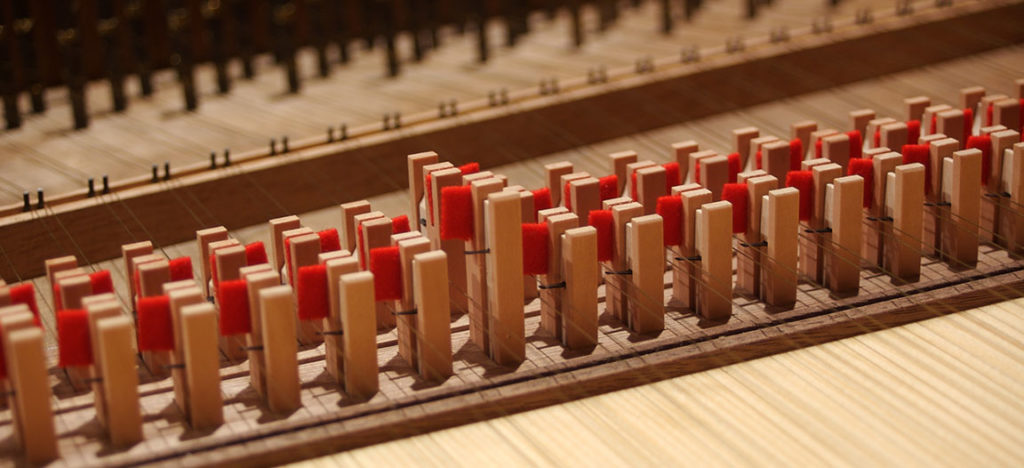 July, 2013 -reviewed by NEW YORK ARTS , Larry Wallach
July, 2013 -reviewed by NEW YORK ARTS , Larry Wallach
BEMF 2013: Review: Feeling the Elephant’s Ear
…..”This great work was performed with a supple flow and expressiveness by the impressive harpsichord player JungHae Kim, who had studied with Leonhardt in Amsterdam. Apparently active mostly on the West Coast, this important artist was one whom I was very happy to get to hear.”
Click here to read the article.
June, 2013 – reviewed by La Folia, Grant Chu Covell
…Arriving at Kim’s D’Anglebert selections after Marchand, Le Roux and Février feels like coming home. I have never listened as closely or enjoyed D’Anglebert as much. Kim’s playing is gallant and regal. She shapes passionate melody into D’Anglebert’s meandering, quasi-vocal lines. Perhaps that’s the secret. By comparison, Marchand and Février are hopelessly foursquare, stuck in left-hand, right-hand patterns.
Kim selects from D’Anglebert’s 1689 publication to fashion Suites in D minor, G major and D major. The largest offering, Variations (22!) on Les Folies d’Espagne, closes the D-minor Suite. There are a few of D’Anglebert’s arrangements of Lully opera tunes. Kim’s concluding work is the D-major Suite’s Tombeau de Monsieur de Chambonnières. The Chaconne Rondeau two tracks before is a delight.
Click here to read the article.
Early Music America – Summer 2012 issue (Vol. 18, Number 2)
Alison DeSimone
Jean-Henri d’Anglebert Pièces de clavecin, 1689 Paris
JungHae Kim, harpsichord www.magnatune.com/artists/jhkim
Unlike his younger contemporaries Elisabeth Jacquet de la Guerre and François Couperin, Jean-Henri d’Anglebert (bap.1629-1691) has not become a canonic figure in the history of Baroque music. The composer held prestigious positions throughout Paris, including as harpsichordist at Louis XIV’s court, succeeding his teacher, Jacques Champion de Chambonnières. Despite such prestige, D’Anglebert published only one book of harpsichord pieces during his lifetime, and on this recording, JungHae Kim gives a select few of these beautiful pieces the attention they deserve. Her playing is emotionally charged yet still sensitive to the fine details that are so essential to French harpsichord technique. Kim excels at drawing out the tension between D’Anglebert’s lyrical melodies and the more rigorous formal structures typical of the French suite.
The first notes of the Suite No. 3 in D Minor set a lush, somewhat mysterious atmosphere for the disc. The harpsichord, a 1996 John Phillips modeled after Nicolas Dumont (1707), produces a gorgeously rounded and resonant tone, made even more beautiful by the low tuning (A-392). Kim’s attention to detail is especially apparent in the unmeasured prelude of this first suite. She takes advantage of the rhythmic freedom, playing with time in order to bring out the luxurious ornamental dissonances for which D’Anglebert is so well known, lingering especially on the notes in this harpsichord’s rich lower register. Kim performs the rest of the suite with an equal amount of freedom, even in the movements that adhere to more strict rhythms. I like her subtle approach to musical time and especially the slow and confident notes inégales in the Allemandes of the three suites. Perhaps her tempo could have been slightly more upbeat in the Courantes, with shorter articulations, much as in the three Gigues included on the recording.
My favorite track on this disc is the Tombeau de Monsieur de Chambonnières, one of the composer’s better-known pieces. This tribute to a former teacher evokes grief and bittersweet nostalgia, and, as Lisa Goode Crawford writes in the program notes, “D’Anglebert creates a vocal line and a harmonic structure that are deeply affecting.” Kim brings out these emotions convincingly, infusing each movement with a subtlety that makes each track more beautiful than the last. Kim’s approach has just the right balance of sensibility and technique; I only wish that this CD included more than just three suites.
Mercury News.com – S.F. Symphony tackles Bach and Handel in ‘Baroque Delights’ series
By Richard Scheinin
05/02/2012
…….The program began with his “Water Music” Suite No. 3 in G major. It was lovely and clear, plucky and buoyant, and swept along by the motion of the continuo — harpsichordist JungHae Kim, cellist Peter Wyrick and double bassist Stephen Tramontozzi, fingers flying. This courtly suite’s very shape was evident in Glover’s gestures, grand sweeps, precision needle-pulls and tucks, high-definition ramp-ups and tamp-downs of volume.
the trumpet-less Adagio did what it was supposed to do: It grew weightless, went walking through space, guided by the cello-harpsichord continuo of Wyrick and Kim. …..